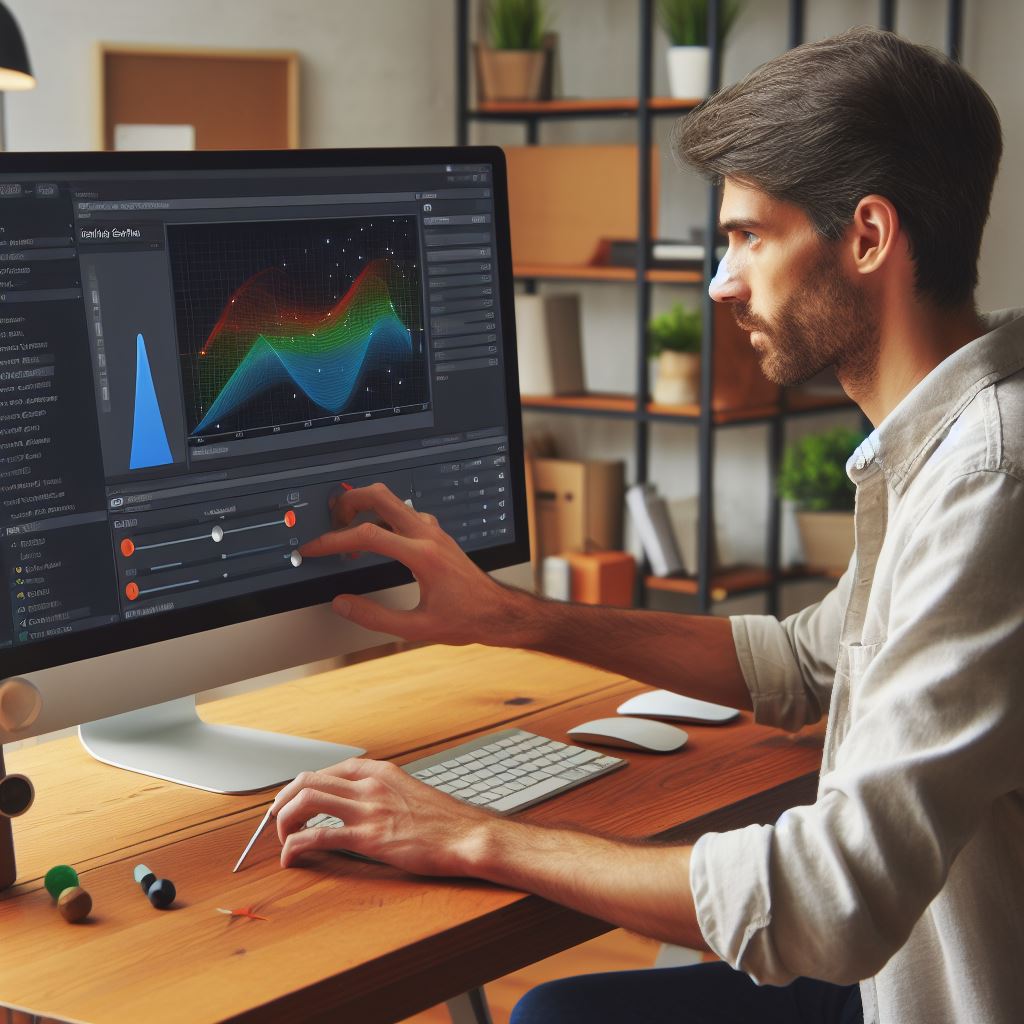Introduction
A. Best Physics Settings for Realistic Gameplay in Unity
In Unity, achieving realistic gameplay hinges on optimizing physics settings.
Let’s delve into the core of this crucial aspect.
B. Importance of Physics Settings in Realistic Gameplay
- Realism: Physics settings simulate real-world behaviors, making your game more authentic and engaging.
- Player Engagement: Accurate physics enhance player involvement, as they interact with a world that behaves as expected.
- Game Mechanics: Physics affect everything from character movements to environmental interactions, shaping core gameplay elements.
- Visual Appeal: Realistic physics add visual appeal by creating natural movements and interactions within the game world.
- Competitive Edge: Games with lifelike physics stand out in the market, attracting a broader audience and boosting success.
This section will guide you through the best practices and settings to make your Unity game world feel as real as possible.
Overview of Unity’s Physics System
A. Unity’s Built-In Physics Engine
Unity boasts a robust physics engine that underpins realistic gameplay.
This engine ensures that your game world adheres to the laws of physics, delivering an immersive experience for your players.
B. Key Components of Unity’s Physics System
- Colliders: These define the shape of an object for collision detection. Unity offers several types like box, sphere, and mesh colliders to suit different needs.
- Rigidbodies: These simulate physical behaviors. Attach a Rigidbody to an object, and it becomes subject to forces like gravity and can move realistically.
- Joints: Unity’s joints connect objects, enabling complex interactions. For instance, hinge joints mimic door-like movements, while spring joints simulate elasticity.
C. Role of Physics Settings in Controlling Behavior
Unity’s physics settings are pivotal in shaping gameplay.
By adjusting these settings, you can achieve various outcomes, from a bouncy, cartoonish world to a realistic, physics-driven environment.
- Gravity: Altering gravity settings determines how objects fall. For a moon-like experience, reduce gravity; for an Earth-like feel, stick to standard gravity.
- Collision Detection: Unity offers options like Discrete and Continuous collision detection. The choice impacts how accurately objects detect collisions, trading off performance for precision.
- Physics Materials: By assigning materials to colliders, you can control friction, bounciness, and sound effects during collisions. For example, you can make surfaces more or less slippery.
- Solver Iterations: This setting influences the quality of physics simulation. A higher value results in a more accurate, but potentially more computationally expensive, simulation.
- Interpolation: This setting smooths object movement, reducing jittery motions. You can tweak it to balance visual fidelity and performance.
- Layer Collision Matrix: Customize which layers of objects can collide. This fine-grained control can prevent unintended interactions.
Understanding and manipulating these physics settings is crucial to achieving the desired level of realism in your Unity game.
Experiment, tweak, and test to find the perfect balance between fun gameplay and true-to-life physics.
Read: Setting up Version Control for Unity Projects: A Tutorial
Importance of Realistic Gameplay
A. Why realistic gameplay is desirable for many game genres
Realistic gameplay is highly desirable for many game genres as it enhances the overall experience for players.
Whether it’s a high-stakes shooter or a peaceful exploration game, realistic gameplay can elevate the level of immersion and make the virtual world feel more alive.
In action-packed games, realistic physics can make combat scenarios more intense and dynamic.
When bullets ricochet off walls, explosions send debris flying, and characters react to being shot, players feel a greater sense of danger and excitement.
Realistic gameplay elements like this can also heighten the tension and challenge, creating a more engaging experience for players.
Tech Consulting Tailored to Your Coding Journey
Get expert guidance in coding with a personalized consultation. Receive unique, actionable insights delivered in 1-3 business days.
Get StartedIn contrast, simulation and strategy games benefit from realistic gameplay as it allows players to make more informed decisions based on how the game world behaves.
Whether it’s the movement of vehicles, the effects of weather, or the dynamics of a city’s economy, accurate physics settings provide a more accurate reflection of reality.
This not only makes the game feel more authentic but also adds strategic depth, requiring players to consider real-world consequences when planning their actions.
B. How physics settings contribute to a more immersive and engaging gameplay experience
Physics settings play a vital role in creating a more immersive and engaging gameplay experience.
By accurately simulating the laws of physics, game developers can make virtual worlds feel more believable and interactive.
One crucial aspect of physics settings is object interaction. When objects in a game world behave realistically, players can interact with them in ways they would expect in real life.
Whether it’s pushing crates, kicking balls, or breaking through crumbling walls, the ability to interact with objects that respond to their actions enhances the immersion and makes the gameplay more satisfying.
Physics settings also affect character movement. Realistic physics allow characters to move and interact with the environment in a way that feels natural.
Whether it’s the weight and momentum of a character’s movements or the way they navigate obstacles, these realistic physics contribute to a more immersive and believable experience.
C. Examples of popular games with realistic physics and their impact on player experience
Many popular games have incorporated realistic physics, making a significant impact on the player experience and setting new standards for immersion in gameplay.
1. Grand Theft Auto V
- This open-world action-adventure game features realistic physics that enable players to experience highly immersive car chases, gunfights, and even water physics that affect the behavior of boats and submarines.
- The lifelike physics contribute to a more engaging and realistic criminal underworld.
2. Battlefield 1
- As a first-person shooter set in World War I, Battlefield 1 utilized realistic physics to create intense and immersive warfare experiences.
- From the destructible environments to bullet drop mechanics, the game’s physics settings added depth and authenticity to the chaotic battlefields.
3. Kerbal Space Program
- This space flight simulation game uses realistic physics to provide players with a challenging and educational experience.
- From calculating gravitational forces to planning complex space maneuvers, the accurate physics settings contribute to a highly immersive and intellectually satisfying gameplay experience.
All these games demonstrate how realistic physics settings can enhance player experience, making the gameplay more engaging, immersive, and unforgettable.
Read: Creating Multi-platform Games with Unity: A Guide

Uncover the Details: Creating a Simple ‘Hello World’ Program in Objective-C
Factors to Consider when Choosing Physics Settings
Physics settings play a crucial role in creating realistic gameplay experiences in Unity.
Build Your Vision, Perfectly Tailored
Get a custom-built website or application that matches your vision and needs. Stand out from the crowd with a solution designed just for you—professional, scalable, and seamless.
Get StartedBy adjusting factors such as gravity, mass, friction, and collision detection, developers can accurately simulate the laws of physics within their games.
A. Gravity
The first factor to consider when choosing physics settings for realistic gameplay is gravity.
Gravity defines the downward force acting on objects within the game world.
Adjusting gravity to match the game’s context is essential for creating a realistic experience for the players.
Whether the game takes place on Earth, in outer space, or in a fantasy world, the gravity settings should align with the game’s physics rules and environment.
In Unity, modifying gravity settings is simple. Open the Unity editor and navigate to the Physics settings.
Here, you can adjust the gravity multiplier to increase or decrease the strength of gravity applied to objects.
Experiment with different values until you find the setting that best matches your game’s desired physics behavior.
B. Mass and Friction
Another factor that greatly influences realistic gameplay is the mass of objects.
Mass determines an object’s resistance to acceleration and impacts its movement and interaction with other objects.
Heavier objects will require more force to move, while lighter objects will be easier to push or manipulate.
Adjusting mass properties can create a more accurate representation of real-world physics within your game.
In addition to mass, friction also plays a vital role in simulating realistic surface interactions.
Friction determines how much resistance an object experiences when moving against another object or surface.
Optimize Your Profile, Get Noticed
Make your resume and LinkedIn stand out to employers with a profile that highlights your technical skills and project experience. Elevate your career with a polished and professional presence.
Get NoticedBy adjusting friction properties, you can create more accurate simulations of objects sliding, rolling, or sticking to different surfaces within your game environment.
C. Collision Detection and Resolution
Accurate collision detection and resolution are crucial for achieving realistic physics simulations in games.
Collision detection refers to the process of identifying when objects collide with each other, while collision resolution involves determining how objects respond to collisions.
Unity provides various collision detection and resolution options.
One important feature is Continuous Dynamic Collision Detection (CCD), which prevents fast-moving objects from passing through other objects without being detected.
By enabling CCD, you can ensure that collisions are accurately detected, allowing for realistic physics interactions.
It is essential to evaluate Unity’s collision detection and resolution options to determine which ones best suit your game’s needs.
Unity provides a range of collision response options, such as bouncing, sliding, or sticking, which can greatly impact the gameplay experience.
When aiming to achieve realistic gameplay in Unity, consider factors such as gravity, mass, friction, and collision detection and resolution.
Adjusting these physics settings allows you to create a more immersive and believable game world, enhancing the overall player experience.
Read: Integrating Unity with Other Technologies: A How-To
Fine-Tuning Physics Settings for Realism
When it comes to creating realistic gameplay in Unity, fine-tuning the physics settings plays a crucial role.
As a game developer, experimenting with different settings is essential to achieve the desired level of realism.
A. Experimenting with different settings
By exploring various combinations of physics settings, developers gain deeper insights into how these settings affect the in-game interactions.
This experimentation phase allows them to understand which settings contribute to a more realistic gameplay experience.
B. Balancing realism and gameplay requirements
While realism is important, gameplay must always remain enjoyable. Striking the right balance between realistic physics and gameplay requirements is a constant challenge faced by game developers.
One approach to finding this balance is by fine-tuning the physics settings. Adjusting factors such as gravity, friction, and object mass can significantly affect gameplay.
Developers should aim to create an immersive experience without compromising the overall enjoyment of the game.
To achieve this delicate equilibrium, here are a few tips for adjusting physics settings:
- Gradually increase or decrease the gravity value to influence the feel of weight and movement in the game.
- Experiment with friction settings to control how objects interact with each other and with different surfaces.
- Adjust the mass of objects to affect their responsiveness and behavior when interacting with other objects or forces.
- Consider implementing custom force and collision algorithms to fine-tune specific interactions in the game.
- Regularly playtest the game with different physics settings to evaluate the impact on gameplay and realism.
- Seek feedback from players or fellow developers to gather different perspectives and iterate on the physics settings.
Remember, achieving the perfect balance between realism and gameplay may require multiple iterations.
It is important to have a clear understanding of the desired gameplay experience and make adjustments accordingly.
Balancing these elements will result in a physics system that feels both realistic and enjoyable for players.
Overall, fine-tuning physics settings significantly affects the level of realism and gameplay experience in Unity games.
Experimentation and iterating on different settings are key to finding the ideal combination.
By striking a balance between realistic physics and satisfying gameplay, developers can create immersive and enjoyable experiences for players.
Read: 5 Essential Unity Extensions for Better Productivity
Conclusion
A. Recap the importance of physics settings for realistic gameplay in Unity
In Unity, physics settings play a crucial role in creating a realistic and immersive gaming experience.
From realistic movements to accurate collisions, physics settings enable developers to bring their virtual worlds to life.
B. Encouraging readers to experiment with different physics settings to create an immersive gaming experience
As a game developer, it is essential to play around with various physics settings and find the perfect balance for your game.
Experimenting with settings such as gravity, friction, and mass can enhance the realism and overall gameplay experience.
C. Call-to-action for readers to leave comments or ask questions about their experiences with physics settings in Unity
We would love to hear about your experiences with physics settings in Unity!
Feel free to leave a comment below or ask any questions you may have.
Let’s engage in a discussion and share our knowledge to create even better games.




